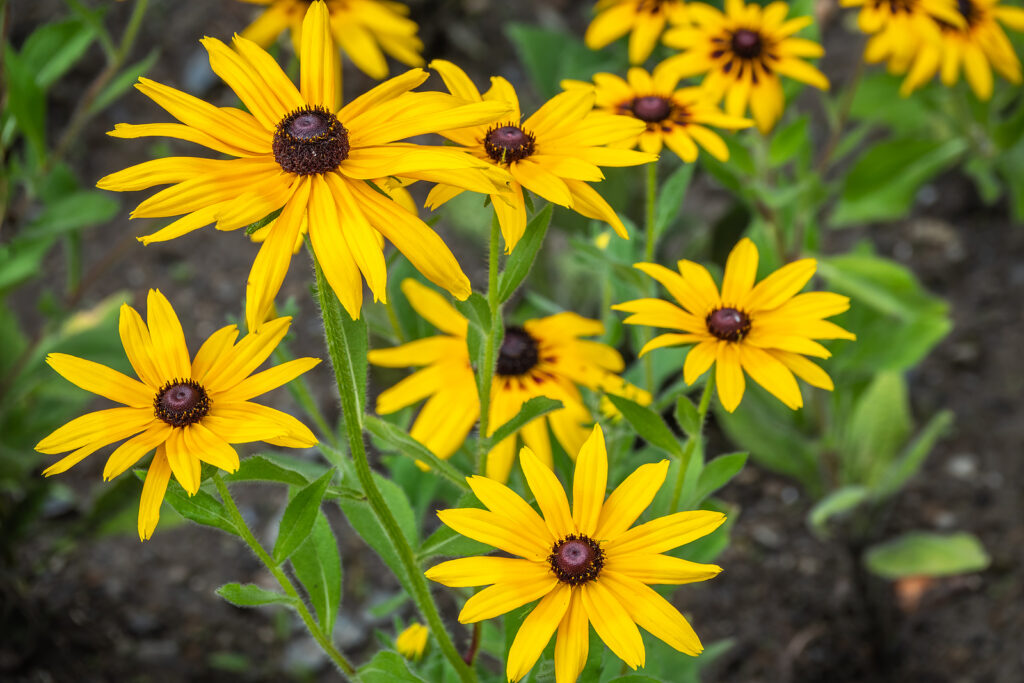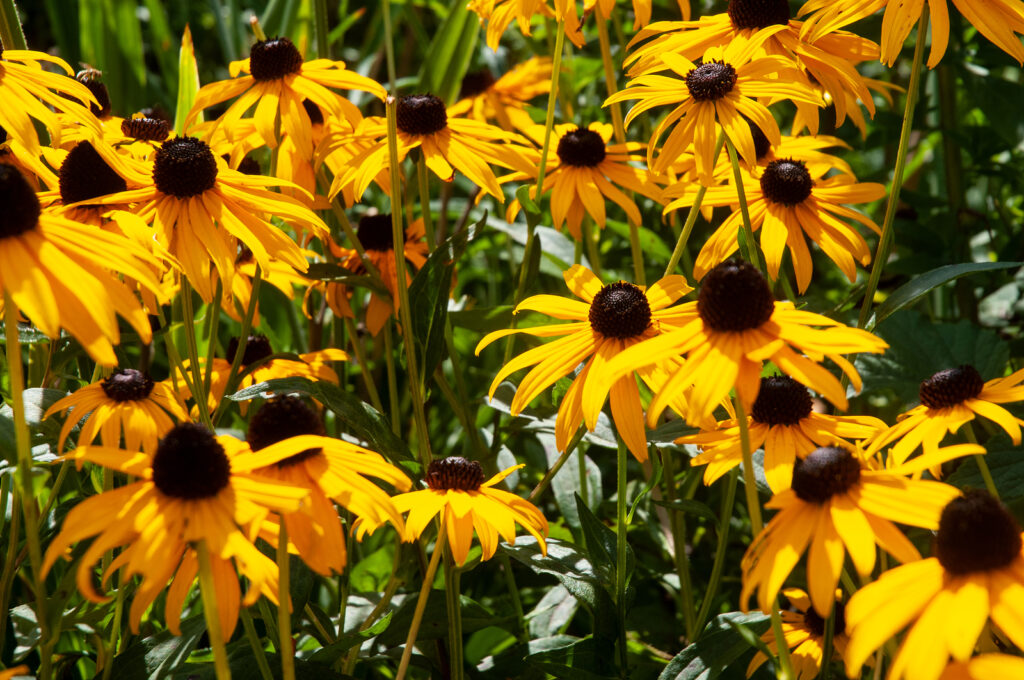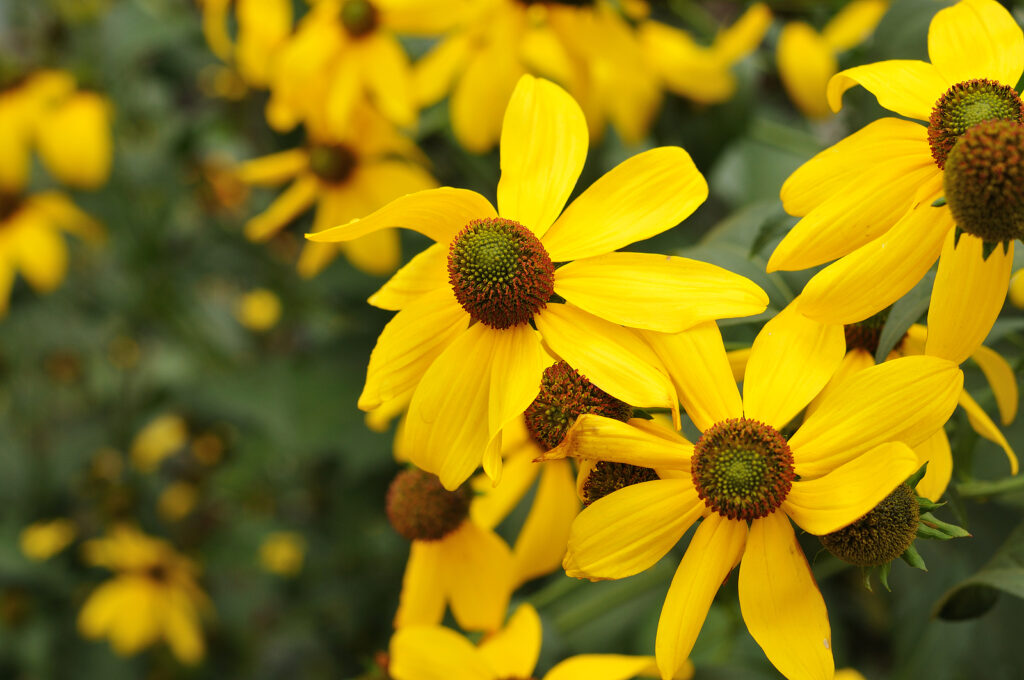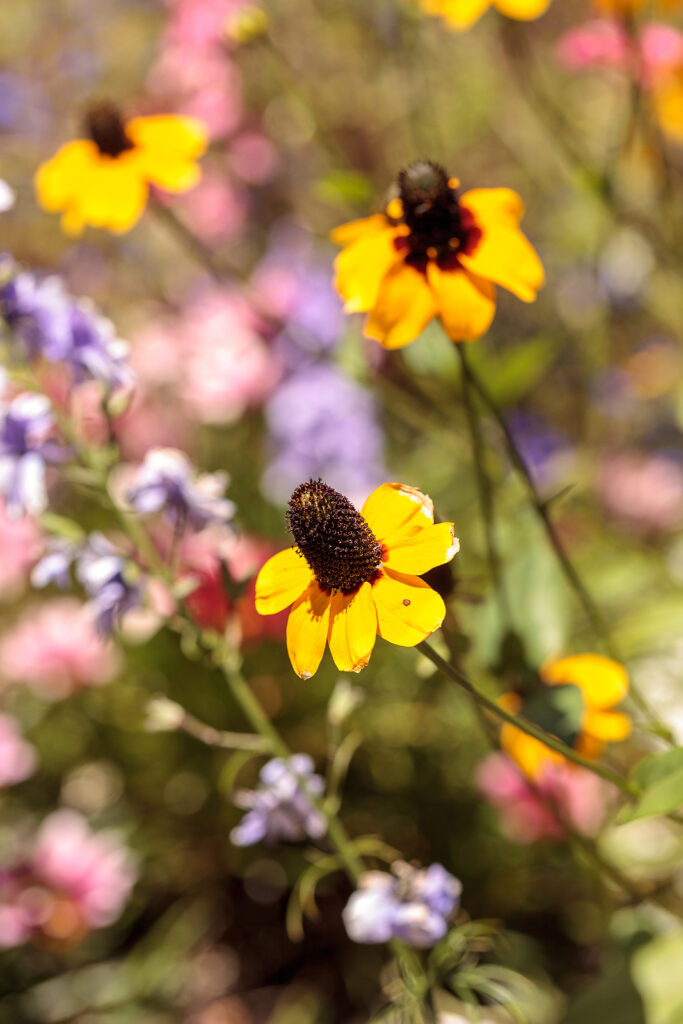Rudbeckia–commonly called black-eyed Susan or gloriosa daisy–produces golden daisy-like, brown-centered blooms from late summer to fall. Black-eyed Susans are tough and easy to grow.
The Rudbeckia genus is made up of about 20 annuals, biennials, and perennials. Garden Rudbeckias are descendants of North American wildflowers.
Rudbeckias thrive in all but soggy soils. They are drought-tolerant once established.
Rudbeckia is probably the brightest bloomer in the late summer and fall garden. They are well suited for perennial borders. Faded flower heads can remain for winter interest in the garden.

Get to know Rudbeckia
- Plant type: Perennial, some grown as annuals
- Growing Zones and range: Zones 3 to 10
- Hardiness: Hardy to -35°F (-37°C); hardy
- in both cold and hot weather
- Height and width: 8 inches (20cm) to 4 feet (1.2m) tall; 2 to 4 feet wide, depending on the variety
- Foliage: Prominently veined, toothed toward the end
- Flowers: Golden daisy-like ray flowers around a dark brown central disc; petals of some cultivars are orange, pale yellow, bronze, or just, sometimes bicolored; flowers can be up to 6 inches (15cm) wide
- Flower colors: Yellow, orange, gold, mahogany, red, and bicolors, sometimes bicolored
- Bloom time: Summer into fall; flowers continue through autumn in Zones 9-11
- Uses: Mixed border, cottage garden, cut flowers
- Garden companions: ornamental grasses, sedums, blazing star, Joe-pye weed, asters
- Common name: Black-eyed Susan, coneflower
- Botanical name: Rudbeckia spp.
- Family: Asteraceae
- Origin: North America
Garden Success Products at Amazon:
- 10 pcs Stainless Steel Garden Hand Tool Set
- Flexi Hose with 8-inch Nozzle
- Gorilla Cart 4 Cu. Ft, 300-pound Capacity
- Neem Bliss 100-% Cold Pressed Neem Oil
- Safer Brand Insect Killing Soap
- Wildflower Seed Mix Attracts Hummingbirds and Butterflies
- Eden Brothers All Perennial Seed Mix
Where to plant Rudbeckia
- Plant Rudbeckia in full sun.
- Rudbeckia grows best in humus-rich to average soil. It will tolerate clay soil.
- Rudbeckia prefers a soil pH of 6 to 7.
Rudbeckia uses and companions
- Grow Rudbeckia in a border, massed for effect.
- Neutralize Rudbeckia in a meadow or woodland garden.
- Most cultivars of Rudbeckia hirta are grown as annuals and are used as bedding or in borders.
- Flowers last well when cut, and cutting promotes continued bloom.
- Good garden companions for Rudbeckia include Achillea, Artemisia, Echinacea purpurea, Echinops, Helenium, Gaillardia grandiflora, Nepeta, Salvia, Sisyrinchium striatum, and ornamental grasses.

When to plant black-eyed Susan
- Set perennial Rudbeckia in the garden in spring or fall after hardening them off. Set plants outdoors when temperatures average 65°F (18°C) or greater.
- Start seed indoors 3 to 4 weeks before the last frost in spring. Plants grown from seeds planted in early spring will bloom the same year. Late-started plants will bloom next year.
- Start seed outdoors in evenly prepared soil after the last spring frost or sow seed outdoors in fall in Zones 9 and 10.
Planting and spacing Rudbeckia
- Indoors, sow seed in six-packs or flats filled with moist, sterile seed starting medium. Sow seed at 70°F (21°C). Do not cover the seeds, just pat them into the soil.
- Germination takes about 14 days under bright light.
- Thin seedlings when they are 3 inches (7.5cm) tall or more; pot up seedlings to individual pots.
- Space Rudbeckia 2 feet apart.

How to water and feed Rudbeckia
- Rudbeckia grows best with abundant moisture; keep the soil evenly moist. Established Rudbeckia will tolerate drought.
- Fertilize Rudbeckia lightly at planting time and in midsummer.
Rudbeckia care
- Mulch around Rudbeckia to conserve soil moisture.
- Rudbeckia does not require fertilizer.
- Stake tall plants to keep them from flopping.
- Trim spent blooms to promote longer flowering.
- Rudbeckia is susceptible to powdery mildew.
Rudbeckia pests and diseases
- Sawflies and aphids may attack Rudbeckia. Treat with insecticidal soap.
- Downy mildew may be prevented by good air circulation.

Rudbeckia propagation
- Propagate Rudbeckia by seed or division.
- Seeds germinate in 14 days sown outdoors after the last frost.
- Seeds germinate in 5 to 7 days at 68° to 72°F (22°C).
- Divide large clumps when new leaves grow in early spring. Separate every other plant. Replant divisions immediately. Spring divide plants should bloom the same year.
Good Products for Seed Starting Success at Amazon:
- Jump Start Germination Station w/Heat Mat Tray, 72-Cell Pack, Dome
- Espoma Seed Starting Mix
- 200 Count- Jiffy 7 Peat Soil Seed Starting Plugs
- Seed Starter Kit with Humidity Dome (120 Cells Total Tray)
- AgrobriteT5 Fluorescent, 2-Foot, Grow Light System

Rudbeckia varieties to grow
- Rudbeckia fulgida: Perennial black-eyed Susan has an orange coneflower. ‘Goldstrum’ is a cultivar that is hardy in Zones 3-9; and grows to 24 inches (61cm) with flowers to 5 inches (12.7cm) wide.
- R. hirta, Gloriosa daisy: Short-lived perennial usually grown as an annual; grows 18 to 24 inches (45-61cm) tall; broad daisy-like flowers in yellow to orange and can be bicolored or striped; several cultivars; easy to grow from seed.
- R. laciniata ‘Gold Drop’: Grows to 24 inches (61cm) tall or greater; pale yellow double flower on wiry stems.
- R. maxima, giant coneflower: Grows 5 to 9 feet (2.7m) tall; bears 3- to 5-inch flowers with orange-yellow ray florets and cone-shaped brown centers.
- R. nitida, shining coneflower: Perennial in Zones 4-10; it grows to 4 feet (1.2m) tall.
Rudbeckia frequently asked questions
Q: What kind of soil and light does Rudbeckia like?
A: Rudbeckia will flourish in any reasonably fertile soil that is not too wet or too dry. Rudbeckia wants full sun. Most Rudbeckia varieties are hardy to -40°F.
Q: What are some uses for Rudbeckia?
A: Rudbeckia’s bright yellow flowers in mid-to-late summer are wonderful cut flowers. Rudbeckias can be planted in large drifts (informally shaped groups) or meadow gardens.
Q: Can I divide Rudbeckia?
A: Yes, you can divide rudbeckia to create new plants. Divide rudbeckia every four years, or more frequently if plants spread quickly.
Q: Can I grow Rudbeckia from seed?
A: Yes. Sow fresh seeds outdoors in late fall. In cold regions, sow seeds in a cold frame. Seeds can be started indoors 6 to 8 weeks before the last spring frost. Stratify seeds by sowing them in flats or pots or moistened medium, covering them with plastic to retain moisture. Refrigerate for two weeks, then set them in a sunny place to grow.















